First Aid Tip: How to Recognise and Treat Heart Attacks
Coronary Heart Disease (CHD) is the leading cause of death worldwide. The WHO report that over 9 million deaths in 2016 were as a result of coronary heart disease. Heart attacks or their medical term ‘myocardial infarctions’ make up a significant proportion of these and it therefore important that any first aider or indeed anyone be aware of the signs and symptoms; it could save a life.
What Is a Heart Attack?
The heart is a muscular organ which pumps blood around the body. Like every other muscle in the body, it requires a good blood supply for itself to ensure enough oxygen & nutrients are delivered and waste metabolic products (such as Carbon Dioxide) are removed.
The heart receives its blood supply from the coronary arteries which branch off from the aorta (the main artery in your body).
If a coronary artery becomes blocked (e.g: due to a clot), then the heart muscle beyond the point of the blockage will not receive an adequate blood supply. This will result in death of the heart muscle which is referred to as a heart attack.
The medical term for a heart attack is ‘myocardial infarction’ (myocardium means heart muscle, infarction is tissue death due to lack of oxygen)
Who has a Heart Attack?
Theoretically anyone can suffer from a heart attack, though they are extremely rare in children (and are normally as a result of another severe illness) and rare in young adults. This is because in order to form a clot you need a build up of ‘fatty tissue’ or cholesterol to accumulate in the coronary arteries via a process referred to as atherosclerosis. Atherosclerosis takes years to progress to a stage where an artery could become blocked and is therefore extremely rare in young adults and children. Typically heart attacks occur in the ‘over 40’s’ however due to lifestyle changes such as obesity and smoking, adults younger than this are experiencing heart attacks. Therefore age should not not cloud your judgement when considering caring for a patient with a suspected heart attack.
How Do I Recognise a Heart Attack?
Common signs & symptoms include:
- Central chest pain, which may spread to the arms/jaw/back/abdomen that does not ease or go away.
- Shortness of breath
- Casualty becomes pale and sweaty
- Fear and anxiety
- Irregular or weak pulse
Not all of these symptoms may be present. In fact, some heart attacks can be ‘silent’ with very little pain which is often mistaken for indigestion. There has been some research which suggests ‘silent’ MIs are more common amongst women and diabetic patients.
If you have any reason to suspect a heart attack, you should treat for one. Its always better to be safe than sorry.
Treatment
Step 1: Call an ambulance/emergency medical help, say that you suspect someone is having a heart attack.
Step 2: Make the person comfortable, if possible ask them to sit on the floor. The best position is known as the “W” position, this involves the person sitting up with their back against a wall with something under their knees to raise them. This reduces the strain on the heart.
Step 3: If you are able to, ask the casualty to chew on a 300mg (big) aspirin. If they have any other medication for their heart (a spray etc.) which a doctor has told them to use in the event of chest pain, then let the casualty use it. Check out our blog post on how aspirin helps in a heart attack.
Try to be reassuring and calm, the casualty will be incredibly frightened and anxious which could aggravate their condition
There is a risk the casualty may loose consciousness. If this happens before the emergency services arrive, place the casualty into the recovery position and monitor breathing. If the unconscious patient stops breathing, start CPR (If the heart attack is large, causing significant tissue death, the heart could stop beating altogether and the patient goes into cardiac arrest).
First Aid for Heart Attack
If someone is having a heart attack, here is what you should do:
- Get the person to sit down. Make sure they rest and help them calm down.
- If they are wearing tight clothes, loosen them.
- Ask the patient if they take any medication for chest pain, and if they do, help them take it.
- In case the chest pain doesn’t go away after resting or after taking the medicine, contact the emergency medical services right away.
- Call 911 if the person is unresponsive, unconscious, doesn’t have a pulse, or is not breathing. Start CPR immediately.
- If the patient is a child or an infant, perform CPR for a minute and then call the local emergency number or 911.
- If the person is unconscious and an automated external defibrillator (AED) is available, follow the instructions to use it on the patient.
How to Prevent a Heart Attack?
The following are some of the ways in which one can try to prevent the risk of having a heart attack:
- Engage in exercise regularly. Try to work out for at least 30 minutes every day.
- Maintain a healthy diet. Include fruits, vegetables, healthy fats, and whole grains in your diet as much as possible.
- Stay away from smoking and tobacco-based products.
- Attempt to lose weight if you’re overweight or obese.
- If you have diabetes, high blood pressure, or high cholesterol, follow your doctor’s instructions to keep it in check.
- Limit your intake of alcohol.
- Get seven to eight hours of sleep every night.
- Indulge in stress-relieving activities, such as meditation, yoga, and journaling.
- Schedule regular checkups with your healthcare provider to ensure your heart is healthy.
What Not to Do if Someone Suffers a Heart Attack?
Here is what you should not do when someone has a heart attack:
- Don’t leave the person alone. Unless there is no one else around who can call for help, don’t leave the patient unattended.
- Don’t panic. Stay composed and do whatever is needed to get the necessary help.
- Don’t let the patient convince you that they don’t require medical attention.
- Do not ignore the symptoms or wait for them to go away. Don’t assume the symptoms are temporary or indicative of something mild. Instead, contact a medical professional right away.
- Don’t let the patient walk, run, or drive to a nearby hospital. This is because excessive movement can worsen the situation.
- Do not give anything to the person by mouth unless it’s a heart medicine prescribed to them by a doctor.
FAQs
What are some of the signs of a heart attack?
Some of the signs of a heart attack are chest pain, cold sweats, and nausea.
How can you avoid having a heart attack?
A couple of the ways to prevent a heart attack are by maintaining a healthy diet, not smoking, and indulging in daily physical activities.
What are some of the foods that are good for the human heart?
Some of the foods that are good for the human heart are oranges, avocados, dark chocolate, and salmon.
How can you stop a mini heart attack?
Stopping a heart attack is not possible. The only thing to do is to call for immediate medical attention.
What are the signs of an unhealthy heart?
If you have an unhealthy heart, some of the signs to watch out for are throat or jaw pain, irregular heartbeat, and shortness of breath.
Conclusion
The key takeaways from this article are:
- A heart attack is one of the most common reasons for a person’s sudden death.
- Someone who has suffered a mild heart attack can be saved by giving the right treatment at the right time.
- When you encounter someone having a heart attack, call the emergency medical services and don’t leave the person alone.
- Certain changes in lifestyle can help in reducing the chances of having a heart attack, such as eating healthy meals and exercising regularly.
- It’s important to be able to recognize the signs of a heart attack so that you can help a person get the required medical attention.
Learn More About Medical Emergencies
Our Advanced Online First Aid Class covers the key medical emergencies that everyone should know about. Sign up today for free!
Refresh Your Knowledge on CPR
Check out our up to date CPR quiz!








I had to laugh a little that you called the victim a casualty. I’ve heard a lot about the silent symptoms and things like that. Sometimes panic attacks can feel like a heart attack. But the pulse is never weak during panic attacks.